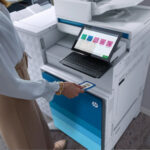An information management system is a system used to receive, track, manage and store documents whilst reducing and minimising paper based documents which are stored in the workplace.
Today, the internet and the cloud has made it possible to access information from coffee shops, airports, or anywhere in the world that users may find themselves. However, access to documents remains a barrier to many remote workers and travellers who rely on people in the office to retrieve files from file cabinets and fax or email those documents.
These inefficient processes result in people chasing paper and sending and waiting for emails instead of enhancing productivity and generating revenue. Many companies today have employees that work exclusively from an office at home and also a growing number of ‘hybrid’ workers who share their time between remote working and the office. These employees need to be able to efficiently and securely access and work with their usual documents and critical information.
The new working environment that we now find ourselves in means organisations must digitally adapt and in turn, allow employees to work efficiently through using an effective Information Management system.
Remote working has become part of many organisations core strategy in 2020 and given the many benefits realised, is likely to remain so being equipped for this working environment is critical for all operations.
Whether you love or hate working from home, your basic requirements to continue working remain similar: you need to communicate with colleagues and co-workers, you need to be able to access data, etc. But perhaps the most critical need of all is Information Management capabilities.
While you’re working from home, how will your employees share, manage, and print documents? You may have to adapt to a new environment of online sharing. That’s where a fully remote Information Management system can help you immensely.















































